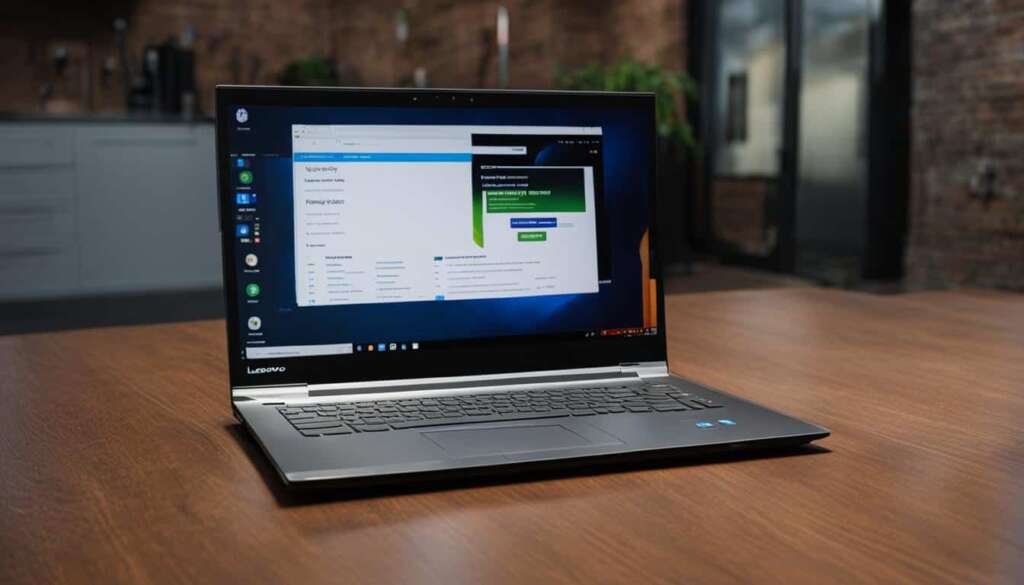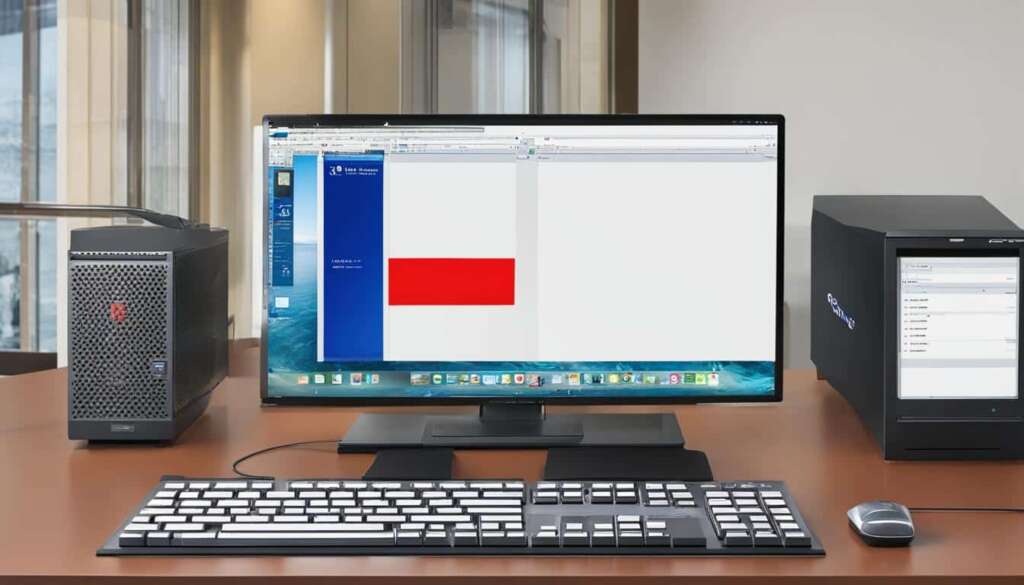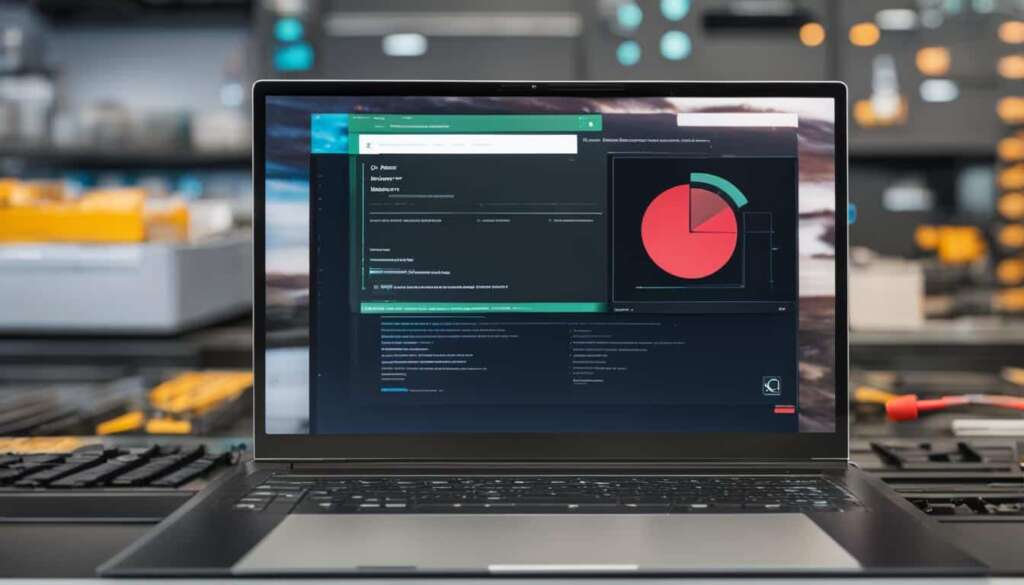Table of Contents
Is your Dell laptop experiencing performance issues or not working as it should? Don’t worry, there’s a solution that can bring it back to life – a factory reset. With our step-by-step guide, you’ll be able to troubleshoot and recover your Dell laptop’s optimal performance. Let’s dive into the world of laptop recovery and reset steps:
Factory resetting your Dell laptop can be the key to resolving various issues, from dealing with a sluggish laptop to encountering errors and malfunctions. By performing a factory reset, you can restore your laptop to its original state and eliminate any software-related problems that may be hampering its performance.
But how exactly do you go about factory resetting your Dell laptop? In the following sections, we will not only guide you through the symptoms that indicate the need for a reset but also provide you with different methods to accomplish it, detail the importance of backing up your files beforehand, and outline the process of restoring your laptop to its original state. We will even cover reinstalling Windows 10 if that’s the route you choose to take.
So, if your Dell laptop is giving you trouble, don’t fret. This factory reset guide will equip you with the knowledge and steps you need to bring your laptop back to its former glory. Stay tuned for the next sections, where we’ll delve deeper into troubleshooting and recovery methods to help you regain control over your Dell laptop.
Symptoms of Dell Laptop Issues
If you own a Dell laptop and have been experiencing performance issues or your laptop is not working correctly, it may be time to take action. Identifying the symptoms of these problems is crucial in determining whether a factory reset is necessary. Here are some common signs to look out for:
- Dell laptop running slow: If your laptop takes an unusually long time to boot up or perform basic tasks, it could be a sign of a larger underlying issue.
- Laptop not working correctly: Frequent crashes, software glitches, or unresponsive hardware can indicate that your Dell laptop is not functioning as it should.
- Laptop not working well: If you are encountering regular errors, freezes, or other problems that disrupt your work or everyday use, it’s essential to address these issues.
To visualize these symptoms, here is a table summarizing the key indicators of Dell laptop problems:
| Symptom | Description |
|---|---|
| *Dell laptop running slow* | A noticeable decrease in speed and overall performance. Slow boot times, delays in opening programs, and sluggish multitasking. |
| *Laptop not working correctly* | Constant crashes, freezing, software errors, unresponsive hardware, or random restarts. |
| *Laptop not working well* | Regular errors, system instability, unexpected shutdowns, or hardware malfunctions that impact daily usage. |
These symptoms can significantly hinder your productivity and frustrate your overall laptop experience. By recognizing these signs, you can determine if a factory reset is a necessary step to address these issues and restore your Dell laptop’s performance.
Methods of Factory Resetting Your Dell Laptop
When it comes to factory resetting your Dell laptop, you have several methods at your disposal. Each method is tailored to suit different needs and situations. Whether you want to perform a system restore in Windows 10, refresh Windows 10 without losing data, reset Windows 10 using Push-Button Reset, reinstall Windows 10 to Dell factory image using WinRE, or reinstall Windows 10 using recovery media, there’s a solution for you. Let’s explore these methods in detail:
Performing a System Restore in Windows 10
If you’re experiencing issues with your Dell laptop and want to revert it to a previous state, performing a system restore in Windows 10 is a viable option. This method allows you to roll back your system to a point where it was functioning optimally. Follow these steps to perform a system restore in Windows 10:
- Open the “Control Panel” and navigate to the “Recovery” section.
- Select “Open System Restore” and choose a restore point from the available options.
- Follow the on-screen instructions to complete the system restore process.
Refreshing Windows 10 Without Losing Data
If you want to refresh your Windows 10 installation without losing your personal files, this method is ideal for you. Refreshing Windows reinstalls the operating system while keeping your personal data intact. Here’s how you can refresh Windows 10 without losing data:
- Go to the “Settings” menu in Windows 10.
- Navigate to the “Update & Security” section.
- Click on “Recovery” and select “Get Started” under “Reset this PC.
- Choose the “Keep my files” option and follow the instructions to complete the process.
Resetting Windows 10 Using Push-Button Reset
If you’re looking for a quick and easy way to reset your Windows 10 operating system, Push-Button Reset is a great option. This method allows you to reset your Dell laptop to its factory default settings. Follow these steps to reset Windows 10 using Push-Button Reset:
- Go to the “Settings” menu in Windows 10.
- Navigate to the “Update & Security” section.
- Click on “Recovery” and select “Get Started” under “Reset this PC.
- Choose the “Remove everything” option and follow the instructions to complete the process.
Reinstalling Windows 10 to Dell Factory Image Using WinRE
If you want to completely wipe your Dell laptop and reinstall Windows 10 to its original factory image, WinRE (Windows Recovery Environment) is the way to go. This method restores your laptop to its initial state, erasing all data and installed applications. Follow these steps to reinstall Windows 10 using WinRE:
- Restart your Dell laptop and press the F8 key multiple times during startup.
- Select “Repair Your Computer” from the Advanced Boot Options menu.
- In the Windows Recovery Environment, choose the desired language and input method.
- Click “Next” and select “Dell Factory Image Restore”.
- Follow the on-screen instructions to complete the reinstallation process.
Reinstalling Windows 10 Using Recovery Media
If you have created recovery media for your Dell laptop, you can use it to reinstall Windows 10. This method allows you to have a physical copy of the operating system that can be used for reinstallation purposes. Follow these steps to reinstall Windows 10 using recovery media:
- Insert the recovery media into your Dell laptop.
- Restart your laptop and press the F12 key during startup to access the boot menu.
- Select the recovery media from the boot menu and follow the on-screen instructions to reinstall Windows 10.
By utilizing these methods, you can easily factory reset your Dell laptop and resolve any issues you may be facing. Remember to back up your important data before proceeding with any reset method to avoid data loss.
Backing Up Your Files Using File History
Before attempting a factory reset on your Dell laptop, it is crucial to back up your files using File History. This step is essential to ensure that you don’t lose any important data during the reset process.
File History is a built-in backup tool in Windows 10 that allows you to automatically back up your personal files to an external storage device, such as an external hard drive or a network location. By regularly backing up your files using File History, you can have peace of mind knowing that your data is safe and easily recoverable.
Here’s how you can back up your files using File History:
- Connect an external storage device, such as an external hard drive, to your Dell laptop.
- Open the Start menu, click on the Settings icon (the gear-shaped icon), and then select “Update & Security.”
- In the left sidebar, click on “Backup.”
- Under the “Back up using File History” section, click on “Add a drive” to select the external storage device you connected.
- Once the external storage device is selected, File History will automatically start backing up your files. You can also click on “More options” to customize the backup settings, such as how often files are backed up and how long they are kept.
- Make sure to keep the external storage device connected to your Dell laptop to ensure continuous backup.
With File History set up, all your important files will be regularly backed up, providing you with a reliable backup solution. In the event that you need to perform a factory reset on your Dell laptop, you can rest assured knowing that your files are safely stored and can be easily restored after the reset.

Comparison of File Backup Methods
| Backup Method | Pros | Cons |
|---|---|---|
| File History | Easily accessible, automatic backups, versioning | Requires an external storage device |
| Cloud Storage | Accessible from anywhere, no need for an external storage device | Dependent on internet connection, limited storage space |
| External Hard Drive | No reliance on internet connection, large storage capacity | Requires manual backups, risk of physical damage or loss |
Restoring Your Dell Laptop to the Original State
Factory resetting your Dell laptop is an effective way to restore it to its original state and resolve any issues you may be experiencing. By performing a factory reset, you are essentially returning your laptop to its default settings, removing any installed apps and drivers that may be causing problems.
Restoring your Dell laptop to its original state can help improve performance and eliminate any unwanted software or bloatware that may have accumulated over time. It provides a fresh start, giving you the opportunity to set up your laptop from scratch and customize it according to your preferences.
To begin the process, you will need to access the system settings on your Dell laptop. This can typically be done by navigating to the “Settings” menu and selecting the “Update & Security” option. From there, you will find the “Recovery” tab, where you can choose the “Reset this PC” option to initiate the factory reset.
Before proceeding with the factory reset, it is crucial to back up any important files or data you have on your Dell laptop. This will ensure that you don’t lose any valuable information during the reset process. Consider using external storage devices or cloud storage platforms to securely store your files.
Once you have completed the backup, follow the on-screen instructions to restore your Dell laptop to its original state. The process may take some time, and your laptop may restart multiple times. It is important to be patient and allow the reset to complete uninterrupted.
After the factory reset is complete, you can begin reinstalling the necessary apps and drivers for your Dell laptop. Be sure to only install trusted software and drivers from reliable sources to maintain the security and stability of your device.
Factory resetting your Dell laptop to its original state can provide a fresh start and resolve various issues. By removing unnecessary apps and drivers, you can greatly improve the performance and functionality of your device. Follow the steps outlined above to restore your Dell laptop and enjoy a pristine computing experience.
Reinstalling Windows 10 on Your Dell Laptop
If you want to reinstall Windows 10 on your Dell laptop, there are two methods you can use: performing a factory image restore using the WinRE (Windows Recovery Environment) or using recovery media. Both options will help restore your laptop to its original state and give it a fresh start.
To perform a factory image restore using the WinRE, follow these steps:
- Start your Dell laptop and press the F8 key repeatedly until the Advanced Boot Options menu appears.
- Select Repair Your Computer from the menu.
- In the System Recovery Options, choose Dell Backup and Recovery.
- Click on Next and follow the on-screen instructions to perform the factory image restore.
If you prefer to use recovery media, which could be a USB drive or DVD, follow these steps:
- Insert the recovery media into your Dell laptop.
- Restart your laptop and press the F12 key repeatedly to enter the Boot menu.
- Select the option to boot from the recovery media.
- Follow the on-screen instructions to reinstall Windows 10 using the recovery media.
Once the reinstallation is complete, it’s essential to install or update the necessary drivers for your Dell laptop. Drivers are software that allow your laptop to communicate effectively with its hardware components. To install or update drivers:
- Go to the official Dell website and navigate to the Drivers & Downloads section.
- Enter your Dell laptop’s model number to find the specific drivers for your device.
- Download the latest drivers for your laptop’s components, such as graphics, audio, and networking.
- Install the downloaded drivers by following the on-screen instructions.
By reinstalling Windows 10 and installing the necessary drivers, you can ensure your Dell laptop is running smoothly and optimized for performance.

Conclusion
In conclusion, performing a factory reset on your Dell laptop can be a game-changer when it comes to reviving its performance and resolving various issues. By following the steps outlined in this comprehensive guide, you can easily navigate through the process and enjoy a fresh start with your Dell laptop.
Whether you are dealing with a sluggish laptop or encountering software glitches, a factory reset can help eliminate these troubles. It allows you to revert your Dell laptop to its original state, removing any unwanted apps and drivers that may be causing problems.
Remember to back up your important files using File History before initiating the factory reset. This ensures that no data is lost in the process. Once the reset is complete, you can reinstall Windows 10 and update any necessary drivers.
So, don’t hesitate to take advantage of the Dell laptop factory reset guide provided here. Give your laptop the recovery it deserves and enjoy a smoother and more efficient computing experience. Follow these laptop recovery steps, and you’ll be amazed at the difference it can make!
FAQ
How do I know if my Dell laptop needs a factory reset?
You may consider a factory reset if your Dell laptop is running slow or not working correctly.
What are the methods available to factory reset a Dell laptop?
There are several methods you can use, including performing a system restore, refreshing Windows 10 without losing data, using Push-Button Reset, reinstalling Windows 10 using the WinRE, or using recovery media.
How can I back up my files before performing a factory reset?
It is crucial to back up your files using File History before attempting a factory reset to ensure you don’t lose any important data.
What happens when I factory reset my Dell laptop?
Factory resetting your Dell laptop restores it to its original state, removing any installed apps and drivers and returning the laptop to its default settings.
How do I reinstall Windows 10 on my Dell laptop?
You can reinstall Windows 10 by performing a factory image restore using the WinRE or by using recovery media. Additionally, installing or updating Windows 10 drivers may be necessary after the reset process.
Can a factory reset revive the performance of my Dell laptop?
Yes, factory resetting your Dell laptop can help resolve various issues and breathe new life into it.













